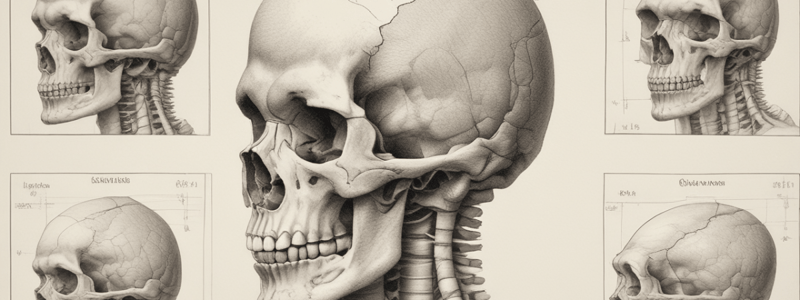Podcast
Questions and Answers
What is the primary mechanism involved in the formation of cartilage tumors?
What is the primary mechanism involved in the formation of cartilage tumors?
- Multistep progression
- Mesenchymal tumor formation
- Abnormal bone development
- Clonal expansion (correct)
What is the most common type of benign cartilage tumor?
What is the most common type of benign cartilage tumor?
- Osteochondroma (correct)
- Chondrosarcoma
- Enchondroma
- Central chondrosarcoma
What is the characteristic feature of an osteochondroma?
What is the characteristic feature of an osteochondroma?
- Location at the bone surface with a continuous stalk with the underlying bone (correct)
- Clonal expansion of cartilage cells
- Formation of cartilage cap in the marrow of bone
- Multistep progression model
What is the approximate percentage of solitary osteochondromas?
What is the approximate percentage of solitary osteochondromas?
What is the term for the process by which a benign tumor becomes malignant?
What is the term for the process by which a benign tumor becomes malignant?
What is the term for the biologic behavior of a tumor that grows rapidly but rarely metastasizes?
What is the term for the biologic behavior of a tumor that grows rapidly but rarely metastasizes?
What is the main reason why adults do not develop new osteochondromas?
What is the main reason why adults do not develop new osteochondromas?
What is the function of EXT genes in normal growth plate development?
What is the function of EXT genes in normal growth plate development?
What is the result of inactivated Hedgehog in mice?
What is the result of inactivated Hedgehog in mice?
What is the role of EXT1 in osteochondroma formation?
What is the role of EXT1 in osteochondroma formation?
What is the characteristic of Enchondromatosis (Ollier disease)?
What is the characteristic of Enchondromatosis (Ollier disease)?
What is the effect of IDH mutations in central cartilage tumors?
What is the effect of IDH mutations in central cartilage tumors?
What is the characteristic of Multiple Osteochondromas (MO)?
What is the characteristic of Multiple Osteochondromas (MO)?
What is the role of IHH in skeletal morphogenesis?
What is the role of IHH in skeletal morphogenesis?
What is the characteristic of osteochondromas?
What is the characteristic of osteochondromas?
What is the result of the progression of osteochondromas towards secondary peripheral chondrosarcoma?
What is the result of the progression of osteochondromas towards secondary peripheral chondrosarcoma?
Flashcards are hidden until you start studying
Study Notes
Classification of Bone Tumors
- Mesenchymal tumors
- Biologic behavior: benign, intermediate (locally aggressive, rarely metastasizing), malignant
- Hallmarks of cancer: clonal expansion, multistep progression model
Cartilage Tumors
- Most benign tumors are cartilage tumors
- Benign cartilage tumors:
- Osteochondroma: bone surface, cartilage cap, stalk continuous with underlying bone
- Enchondroma: in marrow of bone, often in hands and feet
- Malignant cartilage tumors:
- Peripheral chondrosarcoma (~15%): bone surface, secondary to osteochondroma
- Central chondrosarcoma (75%): in marrow, primary or secondary to enchondroma
Osteochondroma
- Almost always arises in long bone, adjacent to growth plates
- Located at bone surface, formation of cartilage cap
- Marrow cavity continuous with that of underlying bone
- 86% solitary (sporadic), 14% multiple osteochondromas (MO)
- Peak age in young patients due to open growth plate
- Adults have a closed growth plate, so they don't develop new osteochondromas
Multiple Osteochondromas (MO)
- Hereditary disorder
- Autosomal dominant
- Can lead to deformation of bones
- Mutations in EXT1 (8q24) or EXT2 (11p)
- 1-5% secondary peripheral chondrosarcoma
Normal EXT Function
- EXT genes responsible for sugar chain attachment to heparan sulphate proteoglycans (HSPG)
- HSPG involved in signaling of FGF, VEGF, Hedgehog, Wnt, and TGFb/BMP
- These pathways are important for normal growth plate
Endochondral Ossification
- Occurs in osteochondroma
- IHH coordinates skeletal morphogenesis
- IHH induces bone collar formation
Osteochondroma Formation
- First mutation in EXT occurs
- Second hit in EXT occurs
- Heparan sulphate proteoglycans is no longer formed, affecting Hedgehog signaling
- Bony collar is not properly formed, resulting in a hole
- Mutant cells grow out, forming an osteochondroma with some normal cells
Progression towards Secondary Peripheral Chondrosarcoma
- Osteochondroma forms a niche for normal cells to acquire other mutations leading to malignancy
- Often, another mutation inactivates cell cycle genes (e.g. INK4 or Trp53)
Central Cartilaginous Tumors
- Enchondromatosis: Ollier disease
- Unilateral predominance
- Non-hereditary
- Rare (1:100,000)
- Risk of malignant transformation 40%
IDH1 or IDH2 Mutations
- Often found in Ollier, secondary CS, and primary central CS
- IDH mutants converge a-KG to D2HG
- D2HG affects DNA methylation and histone modifications
- Inhibition of mutant IDH does not lead to less cell viability and migration
Studying That Suits You
Use AI to generate personalized quizzes and flashcards to suit your learning preferences.




